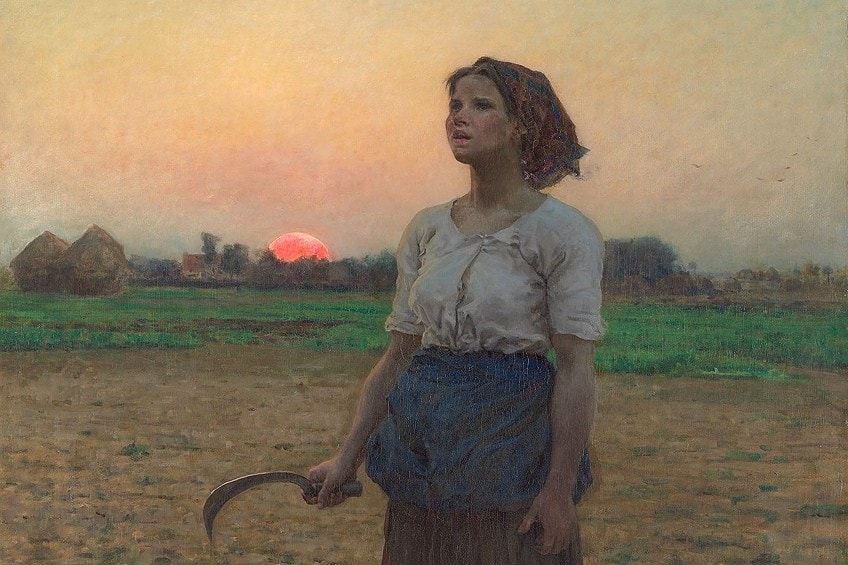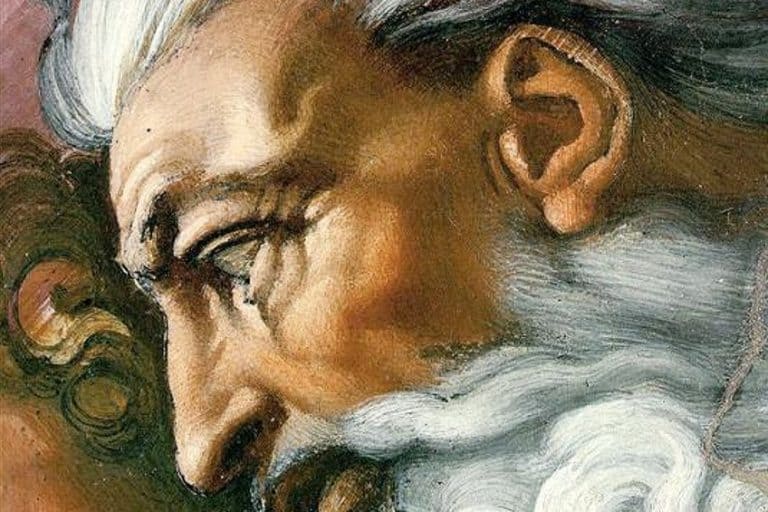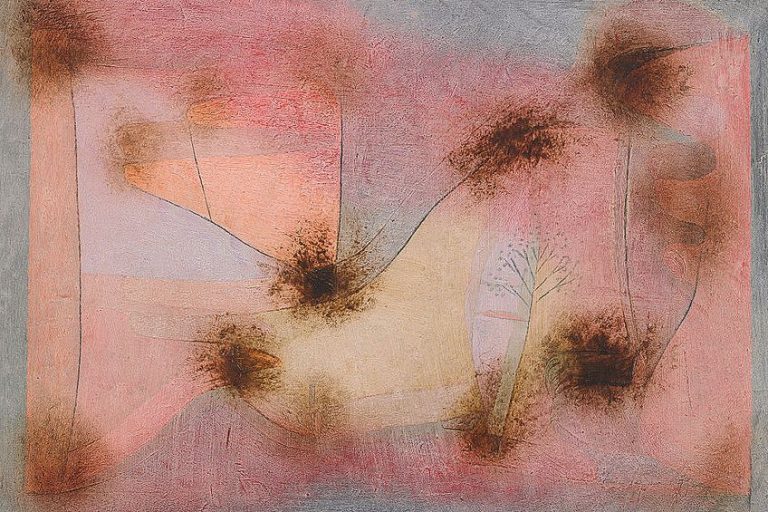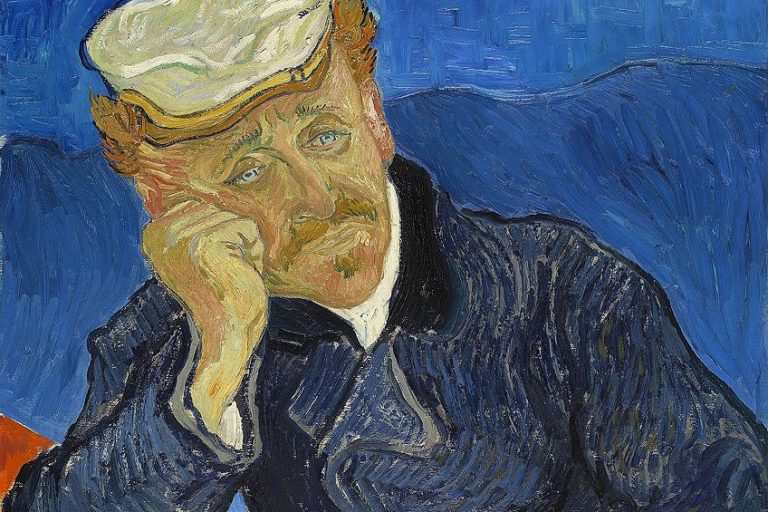“Song of the Lark” Painting by Jules Breton – A Detailed Analysis
Artfully evocative of the human condition, on so many levels, yet strikingly simple, the Song of the Lark painting by Jules Breton renders a rural scene and a brief moment in time that feels as if it might last forever. This article will discuss this painting in more detail.
Artist Abstract: Who Was Jules Breton?
Jules Adolphe Aimé Louis Breton was born on May 1, 1827, in the northern French village called Courrières. He studied at the College of St. Bertin during his younger years and then continued in 1843 at the Royal Academy of Fine Arts in Ghent. In 1847 he moved to Paris and studied at the École des Beaux-Arts.
Breton studied under and befriended numerous acclaimed artists for example Félix De Vigne, Hendrik Van der Haert, Michel Martin Drolling, Gustave Brion, and others.
He also exhibited at the Paris Salon on numerous occasions, becoming a jury member, as well as being Officer and Commander of the Legion of Honor. He also wrote several publications. He died on July 5, 1906, when he was in Paris.
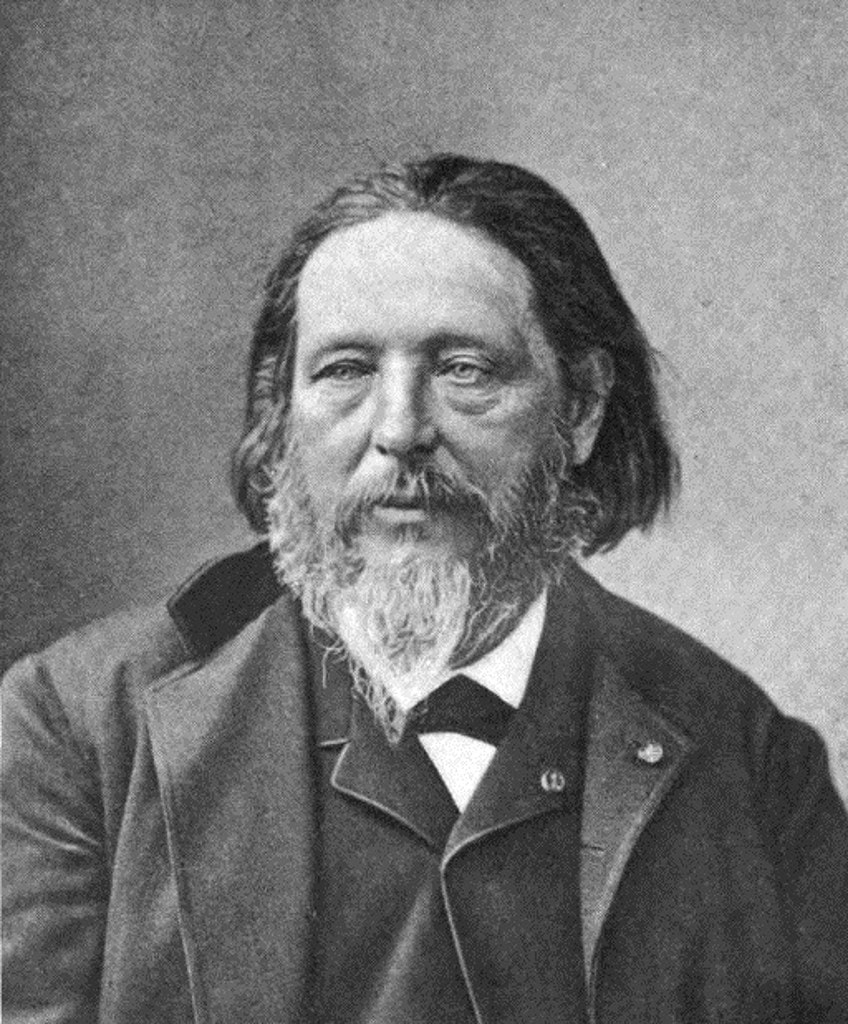
Song of the Lark (1884) by Jules Breton in Context
Song of the Lark (1884) is a famous Realism painting from France, it has become a famous example of rural life, the countryside, and naturalism in painting, following in the footsteps of other famous Realist artists like Gustave Courbet and Jean-François Millet.
Below we will provide a brief contextual analysis for more understanding about the Song of the Lark painting meaning, followed by formal analysis, we will take a closer look at the subject matter and artistic elements utilized in this painting.
| Artist | Jules Adolphe Aimé Louis Breton |
| Date Painted | 1884 |
| Medium | Oil on canvas |
| Genre | Genre painting |
| Period / Movement | Realism, French Naturalism |
| Dimensions | 110.6 x 85.8 centimeters |
| Series / Versions | N/A |
| Where Is It Housed? | Art Institute of Chicago |
| What It Is Worth | The exact price is not available; however, it was bought from Jules Breton by George A. Lucas in 1885 for Samuel P. Avery. |
Contextual Analysis: A Brief Socio-Historical Overview
Jules Breton produced numerous paintings during the 1800s that centered around the theme of rural life and labor. He was a prominent artist in Europe and America, beloved for his rural-themed scenes. It was the First Lady Eleanor Roosevelt’s favorite painting, which she unveiled in 1934 at the Chicago World’s Fair, and it was an inspiration for Hollywood actor Bill Murray during a challenging time in his career.
It is safe to say that Song of the Lark has left a mark on the world, becoming an idyllic icon in many a heart. But how did it all start? What was in Breton’s heart that inspired him to paint such naturalistic and rural scenes?

Breton was born in Northern France, in Pa-de-Calais in Courrières; his family was involved with land, his father reportedly managed land, and so he was exposed to the type of life that is close to nature. However, Breton seemed to have a predilection for peasants and explored this theme in his paintings.
According to several sources about the artist’s life, there were several aspects that spurred him on towards this type of subject matter. Namely, the events from the French Revolution of 1848 and returning to his home village of Courrières on two important occasions.
Reportedly, Breton mentioned how the revolution affected not only himself as an artist, but other artists too, he stated that “there was a deeper interest in the life of the street and of the fields”, further explaining how the “tastes and the feelings of the poor” were acknowledged and that art gave them “honors”; with this, it is clear Breton had a deep-lying reverence towards the “poor”, or possibly, peasants.
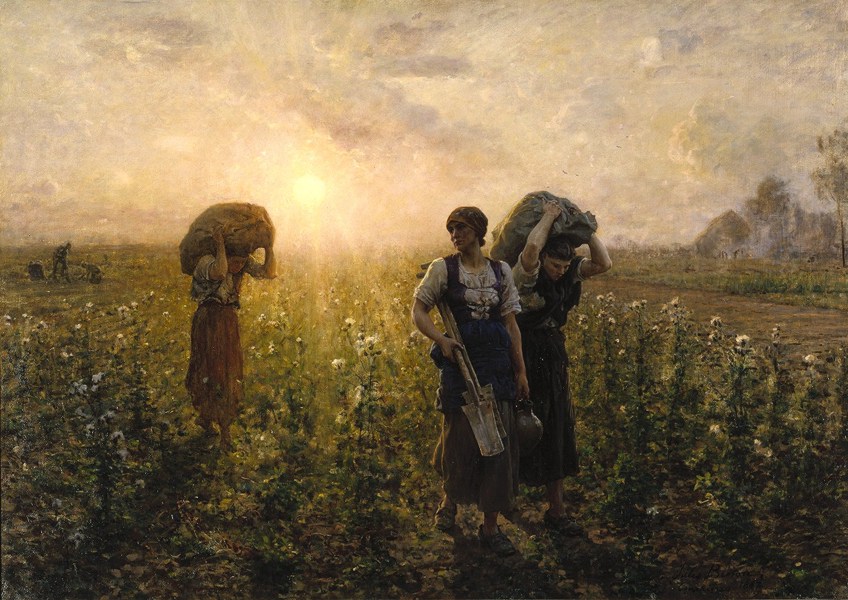
The first important occasion that led Breton’s return to his home village was in 1848. He was living in Paris at the time, was the ill health of his father, who eventually died; reportedly Breton’s family also experienced other difficulties. Due to these various challenges, Breton faced, the revolution and his father’s death, he reportedly stated, “thus it was that which grew up in my artist’s heart – a stronger affection for the nature, the obscure acts of heroism, and the beauty of the lives of the peasantry”.
It is important to note that Breton did not immediately produce peasant paintings of rural scenes. His subject matter was wholly different and within the historical genre, while the love in his heart for rural imagery seemed to have simmered before coming to life.

Often-referenced paintings from his historical genre were Misère et Désespoir (Want and Despair) and Faim (Hunger). These paintings were influenced by the revolution and the social and psychological effects it incurred. Additionally, the above-mentioned paintings have also been described with the Realism art style.
The second important occasion that led Breton’s return to his home village, which was reportedly around 1854, was his ill health. After he moved back, he was more inspired to produce paintings with rural scenes. One of his famous paintings from this time, for which he was given a third-class medal, was The Gleaners (Les Glaneuses) (1854).
Breton continued with the subject matter of rural scenes and explored the peasant lifestyle through his poignant paintings.

However, his style also changed over the years, and he returned to Paris again. He received a wide berth of acclaim for his paintings, not only in Europe but also in America. Some of his artworks were also reproduced because they were in high demand.
In the publication, Jules Breton and the French Rural Tradition (1982) by Hollister Sturges, the Franco-Prussian War during 1870 and 1871 also influenced Breton, and ultimately society. Additionally, his artistic style, really his peasants, were described as more “monumental” and “naturalistic”.
Breton also moved towards depicting single figures in his paintings, often females, as is evident from his “Song of the Lark” painting, among others.
Formal Analysis: A Brief Compositional Overview
Jules Breton became popular for rendering a single female figure in his paintings, and his subject matter has been described as “idealized” and “romantic”, however, throughout it all Breton’s paintings were informed by his unique artistic skills, so let us take a closer look at the acclaimed Song of the Lark painting.
Subject Matter
The Song of the Lark painting depicts a young girl standing with a sickle in her right hand (our left) on a narrow dirt path of what appears to be in a tilled field. Behind her is part of the golden orange Sun rising on the horizon.
The girl is facing us, the viewers, her head is slightly raised with her gaze focused upwards, her mouth is partially opened, and her expression appears rapt, and she is either in deep concentration or awe at something.
From what the title of the painting tells us, her attention is on the song of the lark; assumedly, she needed to stand still and take a moment to listen to the beauty of the bird’s song.
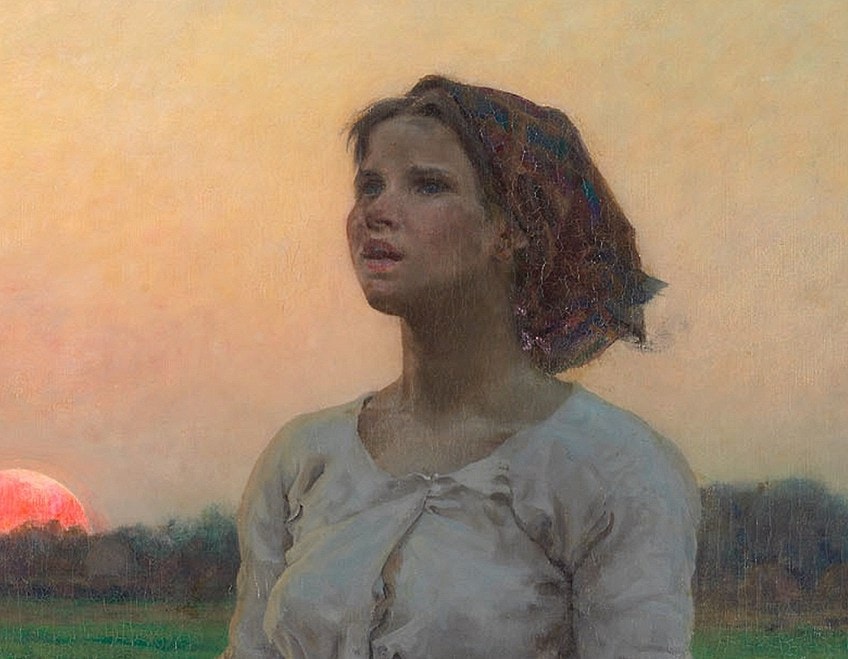
It is clear the girl is portrayed as a peasant, her garb is simple; she is wearing a skirt and a crinkled white blouse with what appears to be a blue wrap around her waist, she has a bandana on her head, and she is barefoot. Furthermore, the girl appears strong in stature, we can see this musculature in her shoulders and arms.
An interesting fact about this girl is that her name was reportedly Marie Bidoul, and she acted as the model for Breton.
If we look at the background we are met with the rising sun in the far distance, and almost a third of the painting is composed of the sky, the other two-thirds of the painting consists of land. Furthermore, in the distance there are brown shapes of what appears to be houses and huts, possibly belonging to the peasants.
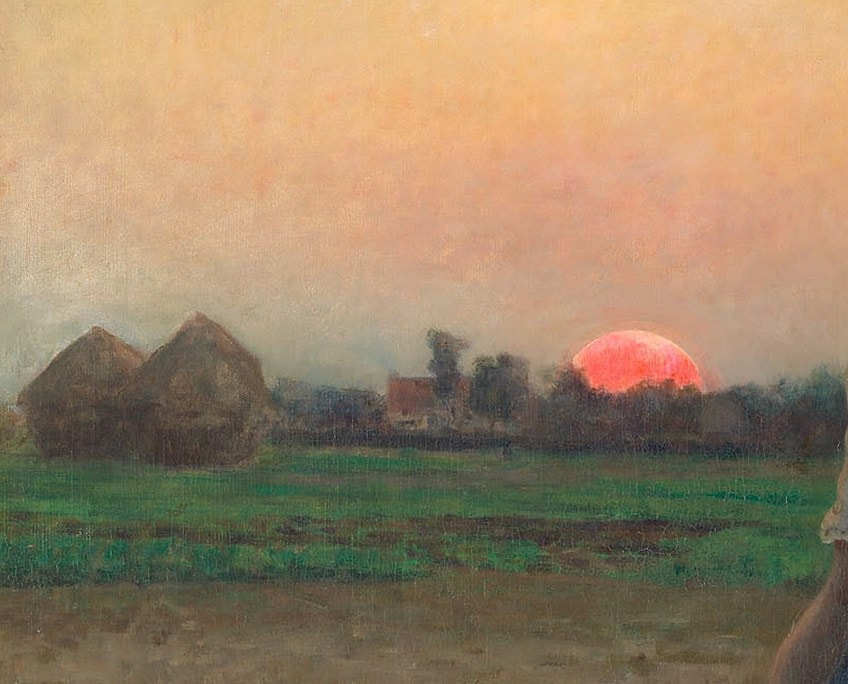
There is also more foliage in the background, trees, and green grass, which eventually becomes the browned field, with some green grass growing here and there. The field is either tilled or barren. We are then met with the girl right in the foreground, standing on the path that leads out of our field of vision from the front and behind the girl.
If we look closely, we might miss it; towards the upper left border of the composition is a small rendition of a bird flying in the sky.
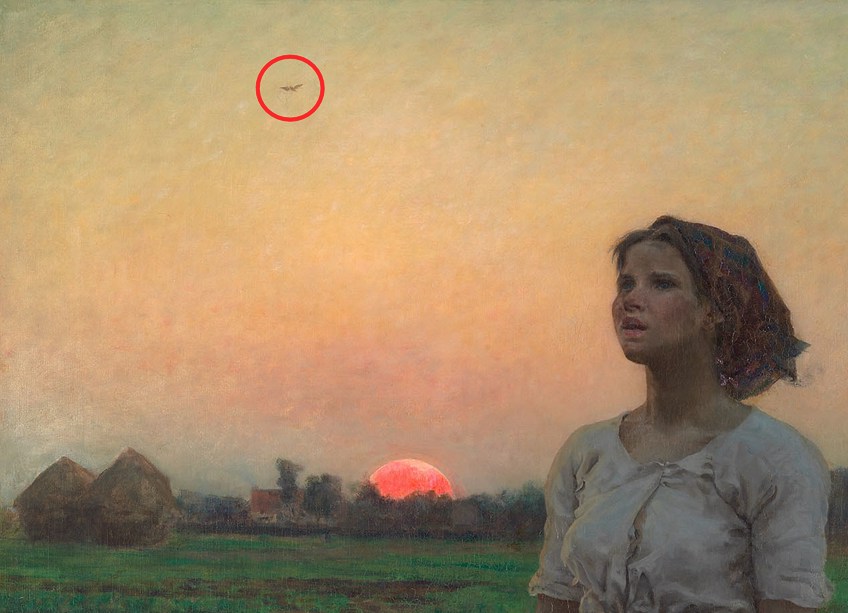
Color and Light
Light becomes a significant part of the Song of the Lark painting with the rising sun as the primary source. This further informs the painting’s overall message, which we will explore in greater depth below. Breton often utilized the sun and the light from it in numerous other paintings of peasant women. One example includes his earlier painting, The Tired Gleaner (1880), and one of his later paintings The End of the Working Day (1886 to1887).

Breton depicts his scene with neutral tones, such as browns, whites, greens, blue, which give an atmosphere of quietude and undoubtedly the still of the early morning. He further utilized softened tones on the sky around the sun, accentuating its vibrant fiery colors. This was also a characteristic of Realism painting; darker colors were often more employed than bright colors.
The Song of the Lark Painting Meaning
The Song of the Lark painting meaning lies in its title as much as it is in the early morning rendering. The Lark is a small songbird and has often been a symbol of “dawn” or “daybreak”, it gives us a clue as to what the girl in the painting is so seemingly enamored with.
She is listening to the morning song of the lark as the new day approaches and she needs to get on with her labor. Essentially, this painting could also be a celebration, so to say, of the working life of peasants, something that was so near Breton’s heart.
However, there have been many scholarly theories around Breton’s portrayal of peasants and his idealistic rendering of them, importantly the inherent interpretations to nature, peasant life, morality, and beauty, and how the perception of what the peasant is has been formed over time through these lenses.
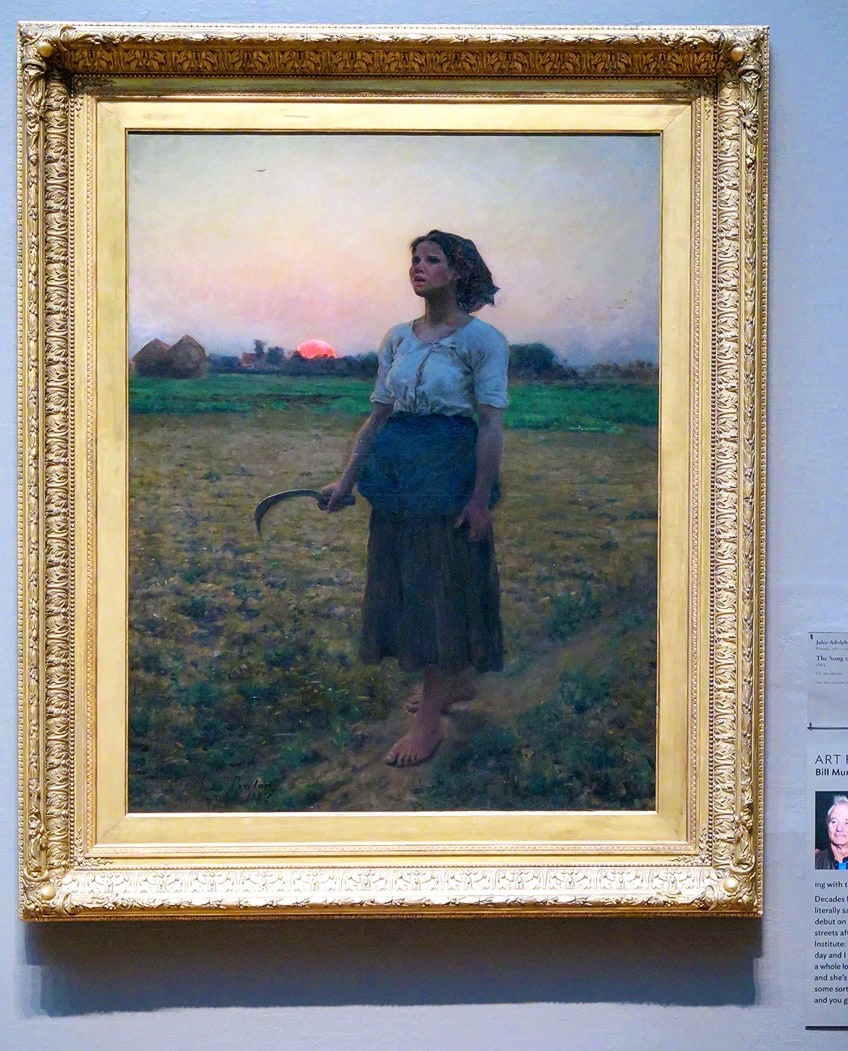
It is important to note that Breton was also a lover of poetry, and so his paintings could also be his visual poetic testimonies of the finer aspects of life. The fact that he also utilized a model to portray the peasant further implies the question of realism and romanticism.
In his dissertation Real and Ideal: The Realism of Jules Breton (2018), Taylor Jensen Acosta mentions various critiques about Breton’s The Song of the Lark painting and its inherent romantic symbolism compared to it as a mere realist painting.
One critique is from André Michel, who was a writer for the French Gazette des Beaux-Arts.
Michel wrote about Breton’s “sentimentality”, stating that “Jules Breton calls upon the aid of poetry to celebrate his old friends, the peasants of Artois. He loves them so much, these old companions of his first success, that he seems to sometimes fear that we will not understand their beauty; it is not enough to understand and admire beauty, one must also proclaim the moral qualities of these good people”.

Acosta provides further examples of scholars who wrote about the painting’s meaning, such as Henri Chantavoine, a French writer, who compared the peasant girl to the lark, describing them both as “these two peasants”.
Chantavoine further explained that “the innocence and the peace of rustic life, the contentment of simple existences and the joy of mother nature smiling at this peaceful happiness, is deliciously expressed”.
The lark was also believed to symbolize the start of a new working day for peasants and was regarded as the peasants’ bird. In Jules Michelet’s, a French historian, book L’Oiseau (1856), he described the lark as “the labourer’s bird” and the national bird of the Gauls.
Furthermore, in Acosta’s dissertation, he also presents the idea that Breton could have portrayed the peasant girl as the lark herself, explaining that the “lark of the title may well refer to both the object of the peasant’s adoration and the peasant herself who sings a song of the morning”.
However, the lark is also connected to symbolism relating to religion and love and, if we look at it in that light, we could also ask the question of whether the girl is in love or not. Furthermore, within a religious scope, was Breton giving the girl a holy aspect in terms of her life as a peasant?
The Song of the Lark Painting in Pop Culture
Jules Breton not only received considerable fame when he was alive, but after his death, his artworks were still in demand and were reproduced as prints, which have been widely sold on the online market. Furthermore, Breton’s The Song of the Lark also left an imprint in pop culture, becoming the subject of a popular book by the American writer Willa Sibert Cather, titled similarly The Song of the Lark (1915).
This novel is about a girl who develops her talents as a musician and a singer, it takes place in Colorado and Chicago.

Breton Holding the Beacon for the Beautiful
Jules Breton was remembered as stating, “I have always had a passion for the Beautiful. I have always believed that the aim of art was to realize the expression of the Beautiful. I believe in the Beautiful – I feel it, I see it! If the man in me is often a pessimist, the artist, on the contrary, is pre-eminently an optimist”.
In “The Song of the Lark” painting by Jules Breton, we are given a poignant image of a young girl who is standing still at a moment in her life when beauty is all she hears, she simply needs to stop for it. Whatever other meanings Breton may have intended for his painting, we are given this moment to share with her, interpreting the moment in our own way.
Take a look at our The Song of the Lark painting webstory here!
Frequently Asked Questions
Who Painted The Song of the Lark (1884)?
The Song of the Lark (1884) was painted by the French Realist and Naturalist painter, Jules Adolphe Breton. He was born in 1827 and became famous for his large-scale paintings of peasants and rural life scenes and depicting their inherent beauty. He was also well regarded for his realistic portrayals, employing traditional artistic techniques.
What Is The Song of the Lark Painting Value?
The Song of the Lark painting value is not readily available; however, it has been reported that numerous of his paintings have been sold for over millions of dollars. According to the Art Institute of Chicago, Song of the Lark was purchased from Jules Breton by George A. Lucas in 1885 and through various hands, it made its way to the Art Institute of Chicago in 1894.
What Is The Song of the Lark (1884) Painting Meaning?
The Song of the Lark painting meaning is about the start of a new day. The lark, referenced in the painting’s title, is a bird, also known as a songbird, that symbolizes dawn or love, and sometimes it also holds religious meaning.
Alicia du Plessis is a multidisciplinary writer. She completed her Bachelor of Arts degree, majoring in Art History and Classical Civilization, as well as two Honors, namely, in Art History and Education and Development, at the University of KwaZulu-Natal, South Africa. For her main Honors project in Art History, she explored perceptions of the San Bushmen’s identity and the concept of the “Other”. She has also looked at the use of photography in art and how it has been used to portray people’s lives.
Alicia’s other areas of interest in Art History include the process of writing about Art History and how to analyze paintings. Some of her favorite art movements include Impressionism and German Expressionism. She is yet to complete her Masters in Art History (she would like to do this abroad in Europe) having given it some time to first develop more professional experience with the interest to one day lecture it too.
Alicia has been working for artincontext.com since 2021 as an author and art history expert. She has specialized in painting analysis and is covering most of our painting analysis.
Learn more about Alicia du Plessis and the Art in Context Team.
Cite this Article
Alicia, du Plessis, ““Song of the Lark” Painting by Jules Breton – A Detailed Analysis.” Art in Context. February 24, 2022. URL: https://artincontext.org/song-of-the-lark-painting-by-jules-breton/
du Plessis, A. (2022, 24 February). “Song of the Lark” Painting by Jules Breton – A Detailed Analysis. Art in Context. https://artincontext.org/song-of-the-lark-painting-by-jules-breton/
du Plessis, Alicia. ““Song of the Lark” Painting by Jules Breton – A Detailed Analysis.” Art in Context, February 24, 2022. https://artincontext.org/song-of-the-lark-painting-by-jules-breton/.


